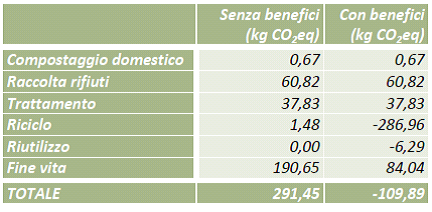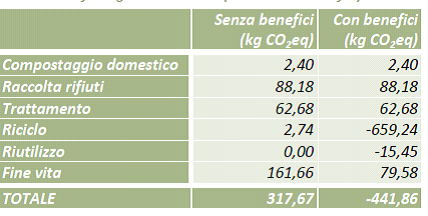SEI is the company in charge of waste management in 100 municipalities in the south of Tuscany (Italy). An LCA which calculated the carbon footprint of the waste management system in 2014 and for two different scenarios for 2021 was recently carried out. In 2014, the level of separate collection of municipal solid waste was 21 %, while for the first scenario for 2021 it was assumed to reach 45 % and for the second scenario for 2021 separate collection was assumed to be 48 %. In addition to the three different cases analysed (waste management system in 2014 and two scenarios for 2021), the carbon footprint differentiated between considering or not the benefits of energy generation from incineration of waste (avoiding the combustion of fossil fuel) and material recovery from waste reuse/recycling (avoiding raw material production). In Table 1, data on the carbon footprint of the SEI waste management system for 2014 (calculated for one tonne of waste) is reported. Note the translations from Italian to English for Tables 1, 2 and 3: compostaggio domestico - domestic home composting; raccolta rifiuti - waste collection; trattamento – treatment; riciclo - recycling; riutilizzo - reuse; fine vita - end of life; senza benefici – without benefits (avoiding the combustion of fossil fuel and avoiding raw material production); con benefici – with benefits (avoiding the combustion of fossil fuel and avoiding raw material production) (Bolognani, 2016).

Table 2 instead reports the carbon footprint calculation for the 2021 scenario of separate waste collection at 45 %.

Finally, table 3 reports the carbon footprint calculation for the 2021 scenario of separate waste collection at 48 %.

From the three tables presented above, it is clear that the highest share of the carbon footprint in the cases without benefits (not considering the avoided combustion of fossil fuel and raw material production) is the end of life related to incineration and landfill. The situation changes substantially when separate collection of waste is increased and the benefits are considered in the carbon footprint calculations (Bolognani, 2016).
The LCA study allowed SEI to understand and assess the carbon savings achievable by improving the separate collection of waste and reducing the amount of waste sent for incineration and disposal in landfill. However, it was also clear from the study that the carbon footprint is not the only possible parameter to evaluate different waste management system options; other indicators (e.g. water use, waste water generation) can also be taken into account to more broadly evaluate the environmental performance.